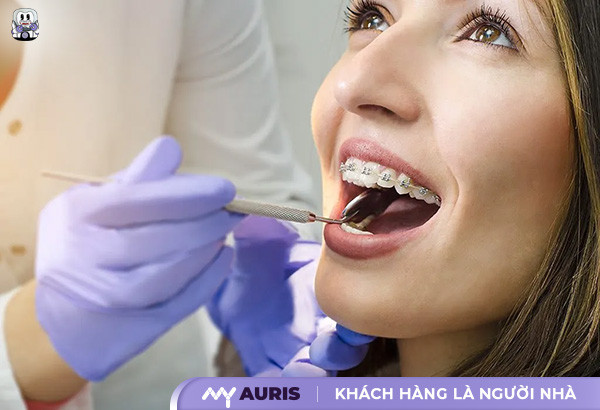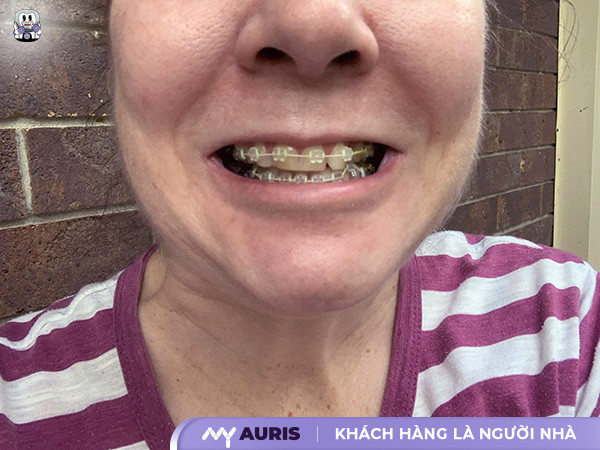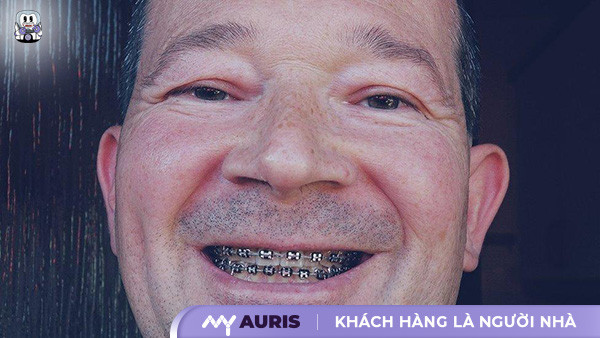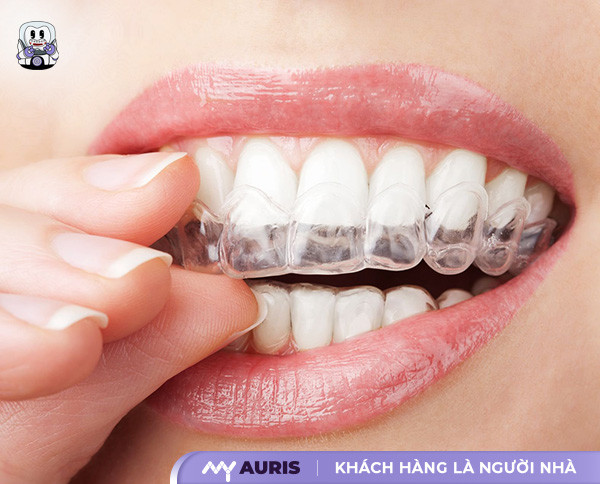What is Braces (Orthodontics)?
Orthodontic bracing is a dental technique that utilizes specialized dental appliances such as brackets, archwires, and clear aligners to apply continuous force, gradually shifting misaligned teeth and jawbones into their correct positions. This method effectively corrects conditions like crooked teeth, overbites, underbites, and gummy smiles, while also improving the bite and creating a set of straight teeth that are harmonious with the face. Braces can also be considered a simple way to restore missing teeth by closing the gap in the area of missing teeth without the need for artificial tooth implantation. The bracing process can last from 1 to 3 years, depending on the individual’s constitution and the severity of tooth misalignment. Notably, braces are not just for children; adults can also undergo treatment, helping them achieve beautiful and healthy teeth.

Should You Get Braces?
Orthodontic bracing is an effective method to improve facial aesthetics, especially for conditions like underbites, overbites, crooked teeth, or malocclusion. According to experts, if you experience tooth misalignment or bite problems, you should consider getting braces. This method uses archwires, brackets, or clear aligners to move teeth into their correct positions, preserving natural teeth and helping to overcome difficulties with chewing. Additionally, braces contribute to protecting oral health, reducing the risk of gingivitis, tooth decay, or bad breath caused by misaligned teeth. However, individuals with periodontitis should not get braces immediately, as orthodontic forces can cause pain, loose teeth, or tooth loss. It is crucial to completely treat this condition before starting orthodontic treatment to achieve the best results.
Advantages
Orthodontic bracing helps improve underbites, overbites, and crooked teeth. Braces also offer numerous benefits for oral health and aesthetics. Straight teeth make oral hygiene easier, reducing the risk of cavities and gum inflammation. Orthodontic treatment improves the bite, supporting better chewing function. A beautiful, more confident smile is a clear result after getting braces. The benefits of braces are long-lasting, positively impacting health and quality of life.
Disadvantages
Orthodontic bracing requires time and expense. The treatment process lasts from several months to several years, depending on the method and the condition of the teeth. The cost of braces varies according to the type of brackets and the dental clinic. Oral hygiene with braces is more complex. Pain during bracing is a common side effect, but it can be managed. Careful consideration is needed before deciding to get braces.

Should You Get Braces at 45?
Can you get braces at 45? The answer is absolutely yes. Orthodontic treatment has no age limit; even if you are 45 and want to improve an underbite, overbite, or malocclusion, it’s possible. However, after 45, the focus of bracing cannot solely be on aesthetics; a thorough assessment of tooth and gum health is also crucial. At this age, teeth and gums have entered the aging phase, meaning tooth movement will be slower and potential risks may be higher. The dentist will conduct careful examinations and X-rays to develop a suitable treatment plan, ensuring high effectiveness and safety for each case.

Should You Get Braces at 50?
Is it advisable to get braces at 50? According to dentists, people aged 50 can undergo orthodontic treatment if their oral health is sound. It is entirely possible to get braces at 50 if you have good oral health and are eligible for dental procedures. Bracing can still be performed if your teeth are in good condition, without significant gum recession, and with healthy enamel. However, this process may face challenges because the jawbone is already stable and teeth are firmly set. Patients need to discuss thoroughly with their dentist to adjust the appropriate traction force, treat any existing oral diseases before orthodontics, and maintain proper oral hygiene along with regular follow-up appointments to achieve the best possible results.

Which Cases Require Braces?
Crooked, Crowded Teeth: Misaligned, crowded teeth make oral hygiene difficult, creating conditions for bacteria to grow, leading to tooth decay and gum inflammation. Braces help rearrange tooth positions, creating even spacing.
Overbite, Underbite: An overbite (upper teeth protrude too much compared to the lower teeth) and an underbite (lower teeth protrude in front of the upper teeth) affect facial aesthetics and chewing function. Orthodontic treatment helps adjust the bite, harmonizing the face.
Malocclusion (Misaligned Bite): A misaligned bite causes difficulty chewing, headaches, and jaw fatigue. Braces help adjust the bite to the correct position, improving chewing function and overall health.
Gaps Between Teeth: Spaces between teeth cause aesthetic concerns and difficulty with pronunciation. Braces help close these gaps, creating a beautiful and even set of teeth.
Jawbone Problems: Uneven development of the upper or lower jawbone affects the bite and facial aesthetics. Orthodontic treatment combined with other methods helps correct jawbone development.
Some of the Most Popular Types of Braces Today
Metal Braces
Metal braces are a traditional orthodontic method that uses metal brackets and archwires to move teeth. The cost of metal braces is typically lower compared to other methods. The treatment duration depends on the tooth condition, usually ranging from 18 to 24 months. Oral hygiene with metal braces requires meticulous care, using specialized toothbrushes and dental floss to clean between teeth.
Advantages: Lower cost, high treatment effectiveness for many complex cases.
Disadvantages: Less aesthetic appeal, causes initial discomfort. Eating with braces requires avoiding hard, sticky foods. Consulting with an orthodontist at a reputable dental clinic is an important step.

Ceramic Braces
Ceramic braces use brackets made from ceramic, whose color closely matches natural teeth, enhancing aesthetic appeal. The treatment duration for ceramic braces is similar to metal braces. Ceramic material has high durability and causes less gum irritation.
Advantages: More aesthetic than metal braces. Post-bracing dental care is equally important to maintain long-term treatment results.
Disadvantages: Higher cost than metal braces, prone to staining if not meticulously cleaned. Various types of ceramic braces are available; patients should discuss with their dentist to choose the appropriate type.

Clear Aligners (Invisible Braces)
Clear aligners are a modern orthodontic method that uses transparent, nearly invisible trays that are easy to remove and insert. Straight teeth and a beautiful smile are desired by many. Clear aligner technology meets high aesthetic demands. The clear aligner process includes the following steps: examination, taking dental impressions, designing the aligner trays, and wearing the trays as prescribed by the dentist.
Advantages: High aesthetic appeal, comfortable to wear, easy to clean.
Disadvantages: Highest cost among all types of braces, requires patients to have high discipline in wearing the trays. Effective treatment for mild to moderate tooth misalignments. Choosing a reputable dental clinic and an experienced dentist is a crucial factor.

My Auris Dental: Quality Standard for a Confident Smile
Are you worried about crooked teeth, overbites, or underbites? Do you want to improve your smile but don’t know where to start? My Auris Dental understands these concerns and is committed to providing optimal orthodontic solutions, helping you feel more confident with a radiant smile.
At My Auris, we prioritize quality standards. Our team of experienced and dedicated orthodontists is thoroughly trained by the Vietnam Dental Association. This is complemented by a system of modern equipment and high-quality orthodontic materials, ensuring safety and effectiveness for all clients. The bracing process at My Auris strictly adheres to medical standards, from consultation to post-treatment care. We believe that a confident smile is the key to success and happiness. Let My Auris accompany you on your journey to creating a perfect smile.
Are you looking for solutions for overbites, underbites, or simply desire a beautiful, even set of teeth? My Auris Dental offers a diverse range of orthodontic services, suitable for all needs and age groups:
- Metal Braces: An economical and highly effective solution for many complex orthodontic cases.
- Ceramic Braces: High aesthetic appeal, almost invisible on teeth.
- Clear Aligners: Comfortable, discreet, easy to remove for eating and cleaning.
- Other types of braces: Depending on the tooth condition and aesthetic needs, the dentist will advise on the appropriate type of braces.
In addition to orthodontics, My Auris also provides other dental services such as implant placement, porcelain veneers, teeth whitening, tooth extraction, and scaling. We are committed to providing you with the most comfortable and safest dental experience.
My Auris Dental always prioritizes the interests of its clients. We are committed to delivering quality dental services, helping you achieve a confident and healthy smile. Contact us now for a free consultation!





